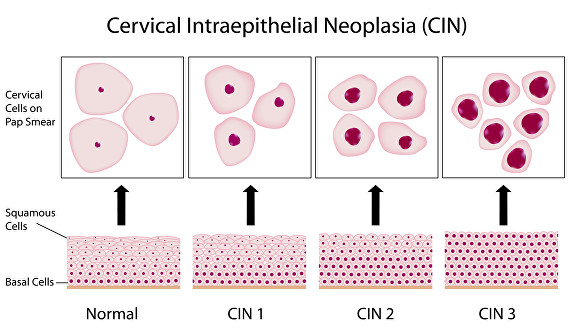A cervical screening test (previously known as a smear test or PAP test) is a method of detecting abnormal cells on the cervix. The cervix is the entrance to the womb from the vagina.
Detecting and removing abnormal cervical cells can prevent cervical cancer.
Cervical screening is not a test for cancer – It is a test to check the health of the cells of the cervix.
Most women’s test results show that everything is normal, but for around 1 in 20 women, the test will show some abnormal changes in the cells of the cervix.
Most of these changes will not lead to cervical cancer and the cells may go back to normal on their own.
However, in some cases, the abnormal cells need to be removed so that they cannot become cancerous.
About 3,000 cases of cervical cancer are diagnosed each year in the UK, which amounts to 2% of all cancers diagnosed in women.
It’s possible for women of all ages to develop cervical cancer, although the condition mainly affects sexually active women between the ages of 30 and 45. The condition is rare but not unheard of in women under 25 years of age.
The smear test itself
The cervical screening test usually takes around five minutes to carry out. An instrument called a speculum will be gently inserted into your vagina to hold the walls of your vagina open so that your cervix is visible.
A small soft brush will be used to take some cells from the surface of your cervix.
The sample of cervical cells will then be sent to our laboratory and examined under a microscope to see whether there are any abnormal cells.
Some women may find the procedure a bit uncomfortable or embarrassing, but for most women, it is not painful.
If the test picks up abnormalities in the cells in your cervix, it may be recommended that you have treatment to remove them, or further tests in a few months to see if they return to normal on their own.
A chaperone will be offered in all cases.
HPV – Human Papilloma Virus
Changes in the cells of the cervix are often caused by the human papillomavirus (HPV).
There are more than 100 different types of HPV. Some types are high risk and some types are low risk.
HPV-16 and HPV-18 are considered to be high risk for cervical cancer.
If a sample taken during for cervical screening test shows low-grade or borderline cell abnormalities, the sample will automatically be tested for HPV. If HPV is found in your sample, you should be referred for a colposcopy for further investigation and, if necessary, treatment.
If no HPV is found, then you will carry on being routinely screened as normal.
If your sample shows more significant cell changes you will be referred for colposcopy without HPV testing.
The results of your screening test will usually be available after 3-4 working days.
The smear test carried out on your sample is to look for abnormal cells (‘cytology’), then the results you may get are as follows.
Normal
A normal test result means that no abnormal cell changes have been found. No action is needed and you do not need another cervical screening test until it is routinely due.
Inadequate
You may be told that you need to have a repeat test because the first one could not be read properly. This may be because not enough cells were collected, they could not be seen clearly enough or an infection was present.
If this the case, you will be asked to go back so that another sample of cells can be taken, usually after about three months.
Abnormal
If you have abnormal results, you may be told that you have:
Borderline or low-grade changes (called ‘dyskaryosis’)
Moderate or severe (high-grade) dyskaryosis
If your result is low-grade, it means that although there are some abnormal cell changes, they are very close to being normal and may disappear without treatment.
In this case, your sample will be tested for HPV. If HPV isn’t found, you are at very low risk of developing cervical cancer before your next screening test. You will be invited back for routine screening.
If HPV is found, you will be offered an examination called colposcopy, which looks at the cervix more closely.
If your result is high-grade dyskaryosis, your sample will not be tested for HPV, but you will be offered colposcopy in order to check the changes in your cervical cells.
All these results show that you have abnormal cell changes.
This does not mean that you have cancer or that you will get cancer. It just means that some of your cells are abnormal and if they are not treated they may have the potential to develop into cervical cancer.
Colposcopy
A colposcopy is a simple examination that uses a special microscope called a colposcope to examine your cervix. This is performed by a consultant gynaecologist at the hospital.
Having colposcopy is very much like having cervical screening.
It can identify the extent of abnormal cells and helps determine whether you need treatment.
A small sample of tissue (biopsy) may also be taken from your cervix during colposcopy.


Advantages of attending Regent Street Clinic™ for your cervical smear test (PAP test)
- Doctor-led service
- Cervical smear tests can be offered to all sexually active women, including those under the age of 25 years
- Chaperones are always available during the test
- Comfortable, private surroundings using the latest ThinPrep liquid cytology techniques
- Average patient discomfort score only 2/10
- Increased accuracy of results with high sensitivity and specificity
- Fast turnaround of results, typically within 3-4 working days
- Same-day appointments available
- Results discussed with the doctor face to face
- Tests can be undertaken at yearly intervals rather than 3-yearly for optimal peace of mind
- Immediate referral to private consultant gynaecologist if abnormal result.

